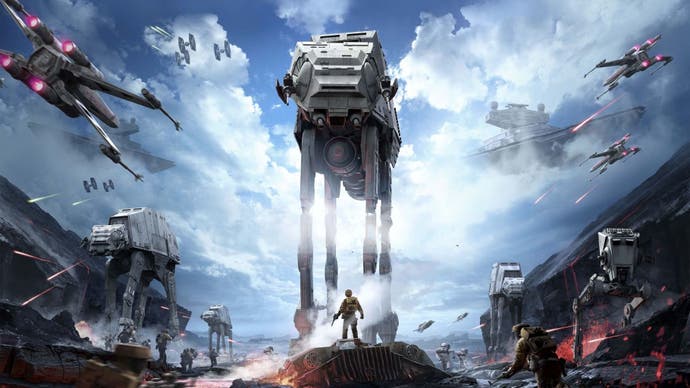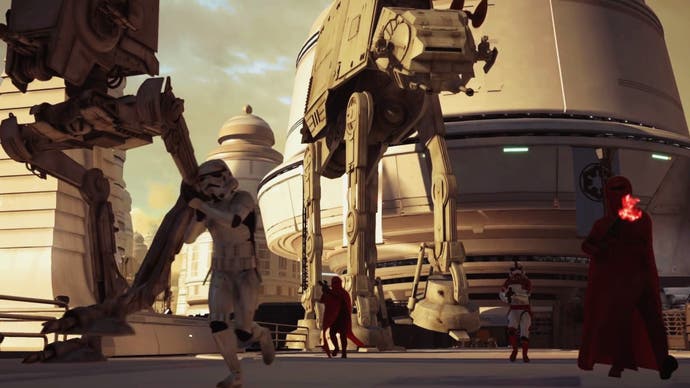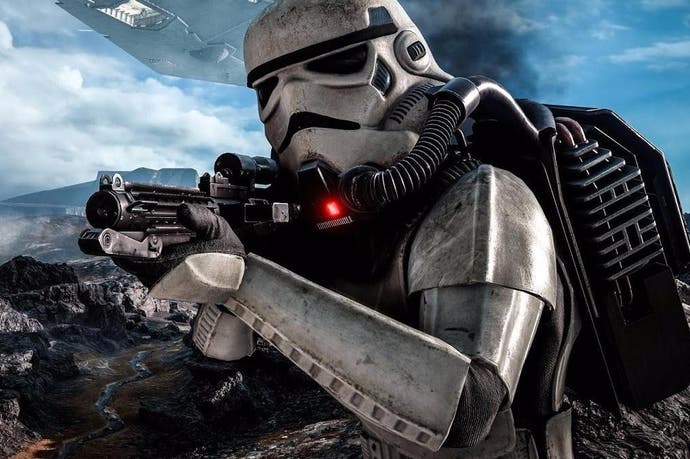How DICE's Star Wars Battlefront struck back
And what Battlefront 2 should learn from it.
Star Wars Battlefront took its time to come good. It wasn't until the end of 2016, when the Death Star DLC dropped and completed the package, that it finally delivered on its considerable promise. Having burned plenty of early purchasers who paid full price for a content-light game at launch, EA DICE bigwigs have their work cut out to bring back singed-finger fans for the sequel. A proper campaign option would be one way of winning people over, but a better approach is perhaps to look at what the first game (eventually) got right - in particular, the Walker Assault mode on Hoth, Sabotage on Bespin and Battle Stations on the Death Star.
Before we look at the strengths of these modes, it's worth going over why Battlefront initially left consumers a little cold. In the game's favour, it looked gorgeous and successfully recreated the look and feel of the movie's sets. It remains a simple yet fast-paced FPS that both appealed to a broader audience and created a uniquely kamikaze play style, befitting the disposability of grunts in the Universe. It also had an eye for emergent setpiece moments, with the sudden arrival of a hero or a rapid firing AT-ST shaking up the situation.

But it was also quite lightweight. A paucity of maps, a number of duff supplementary game modes outside the big team battles and the occasional odd choice of setting like Sullust made Battlefront feel like it was missing something. These failings were thrown into stark relief by the decision to make Hoth's Walker Assault mode the principle focus of the pre-launch multiplayer beta. The mode was the logical choice because it showcases Battlefront at its best, a three phase 20v20 battle that culminates in a desperate speeder versus AT-AT showdown in the shadow of a shield generator - one of the finest moments in the Star Wars series thrust perfectly into the confines of a multiplayer mode. But the strength of Walker Assault on Hoth overshadowed the rest of the game.
In short, what Battlefront needed at launch was more content like Hoth. It needed modes that captured not just the spirit of the Star Wars universe, but also the specificity of the stories that have made the series compelling. It wasn't until months after launch that Battlefront offered that consistently - the game's first season pass content drops were the relatively underwhelming Jakku and Outer Rim expansions, which failed to build on Hoth's snowy delights.
With the release of the Bespin and Death Star DLC packs, however, Battlefront finally gained two modes worthy of its promise, beginning with the Sabotage mode on Bespin. Its premise is simple: the Rebels have to blow up three Tibanna generators before defending a landing pad and the Imperials must stop them. But Sabotage works beautifully in Battlefront because of how it utilises legendary characters.

Each side has the chance to grab hero tokens, but they have to take it in turns to get them. The Rebels get to bring out the likes of Han and Chewie first, but the round ends with Vader and Fett on the scene. The result is a battle with a genuine ebb and flow. In the confines of the carbonite chambers, the Rebels initially lead a devastating attack before they have to desperately hold out against counterattacking Stormtroopers and Sith Lords. It's dramatic, it's fun and, most importantly, it makes you feel - as Walker Assault on Hoth did - that you're bang in the middle of The Empire Strikes Back.
But if Sabotage feels like a deleted scene from Episode V, then the Battle Station mode in the Death Star DLC - the second impressive addition to the game - is a homage to a New Hope played out over three acts. The first of these sees the Rebels attempting to take down a Star Destroyer (and doing so successfully, unless they are monumentally indolent). The second act switches to the halls of the Death Star, as the Imperials try to stop the Alliance jail-breaking R2-D2. And, as you can all probably guess, everything rounds off with a good old ruckus in the Death Star trenches.
As with Sabotage, Battle Station works well because it is marries the best aspects of Battlefront with the films so tightly. In the space sections, the addition of familiar Star Wars-driven objectives provides focus for both sides. While Battlefront's dogfighting mode Fighter Squadron quickly becomes a bout of generic team deathmatch in space, the challenge of shooting down a Star Destroyer or making a successful trench run introduces interesting tactical elements to the battle.
Furthermore, these sections fit around a chaotic on-foot section that is in keeping with the source material. The liberation of R2-D2 by the Rebels is structured in the same way that Leia is rescued in A New Hope, in that a rapid attempt to extract a prisoner leads to a chaotic escape. But the decision to force a rescuer to adopt the role of R2-D2 and trundle the droid out of the station creates conditions for a deadly close-quarter battle between Rebels and Imperials that works perfectly in a team shooter.
In short, Battle Stations, along with Walker Assault on Hoth and Sabotage on Bespin, successfully draws on fan knowledge of Star Wars and marries it to appropriate mechanics. Whether you're the hero racking up kills to save the day, or the cannon fodder charging into a Rebel control point to help capture it, the Star Wars element of Battlefront no longer feels like convenient branding.
Instead, it helps elevates each of these modes above what the rest of Battlefront offers. Playing team deathmatch in a Star Wars skinned world is one thing, but setting up battles that feel like they genuinely mean something in that universe is another. It's up to DICE to learn the lessons of the first game's belated success and make sure that the Force is as strong as possible with Battlefront 2.


